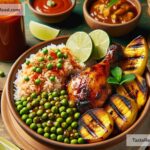The Influence of Cajun and Creole Cooking
Cajun and Creole cooking is a delicious part of American food culture. These styles come from Louisiana, a state in the southern United States. Over time, they have had a big influence on cooking across the country and even around the world. Both Cajun and Creole dishes have unique flavors and use ingredients that tell a story of history, tradition, and blending cultures.
What is Cajun Cooking?
Cajun cooking comes from the Acadians, French-speaking people who lived in Canada. In the late 1700s, they were forced to leave Canada and moved to Louisiana. These people brought their cooking traditions with them. Cajun food is known for being hearty, flavorful, and made with simple ingredients. It grew out of the need to make meals from whatever was available.
Cajun cooking often uses what is called the “holy trinity” of vegetables: onions, bell peppers, and celery. You’ll find these in almost every Cajun dish. Cajun food is also famous for using bold spices, but it’s not always super hot—it’s more about deep flavor. Some common seasonings include cayenne pepper, paprika, thyme, and garlic powder.
Popular Cajun dishes include gumbo, jambalaya, and crawfish étouffée. Gumbo is a thick, stew-like dish made with meat, seafood, and okra. Jambalaya is a rice dish mixed with meat, vegetables, and spices. Crawfish étouffée is made with crawfish, a local freshwater crustacean, in a rich, flavorful sauce served over rice.
What is Creole Cooking?
Creole cooking also comes from Louisiana, but it has a different story. It is influenced by the diverse groups of people who called New Orleans home. Creoles were descendants of French settlers, but they were also influenced by Spanish, African, Caribbean, and Native American cultures. Later, even Italian and German traditions became part of Creole cooking.
Creole food is often seen as a little fancier than Cajun food. It often uses a larger variety of ingredients, including tomatoes, butter, cream, and wine. Creole dishes are known for their rich, layered flavors. Like Cajun cooking, Creole food often uses the “holy trinity” of vegetables, but with extra ingredients to enhance the dishes.
Popular Creole dishes include shrimp creole, red beans and rice, and Creole gumbo. Shrimp creole is made with fresh shrimp cooked in a spicy tomato-based sauce, often served over rice. Red beans and rice is a comforting, affordable dish made with slow-cooked beans, sausage, and rice. Creole gumbo uses seafood, sausage, chicken, and other rich ingredients to make a robust, flavorful stew.
The Difference Between Cajun and Creole Cooking
Many people confuse Cajun and Creole cooking because they overlap in some ways. Both food styles come from Louisiana and use bold flavors, seafood, and rice. However, there are some key differences.
The main difference is that Cajun cooking is more rustic and “country-style,” while Creole cooking is more refined and “city-style.” Cajun food often uses simple ingredients and techniques because it comes from rural areas. Creole food, on the other hand, uses more elaborate ingredients and techniques because it developed in New Orleans, which was a major cultural center.
Another big difference is the use of tomatoes. Creole dishes often include tomatoes, while Cajun dishes usually do not.
The Influence of Cajun and Creole Cooking
Cajun and Creole cooking has had a huge impact on American food culture. Many Louisiana dishes became famous because they taste so good—and they’re fun to make! Restaurants across the United States now serve gumbo, jambalaya, and crawfish boil-style dishes. Famous chefs like Paul Prudhomme helped popularize Cajun and Creole cooking in the 1980s, and it remains popular today.
Outside the U.S., Cajun and Creole flavors inspire people all over the world. The use of spices, fresh seafood, and comforting ingredients makes these dishes appealing to everyone. Cookbooks, television shows, and food festivals introduce these flavors to new audiences every year.
In addition, Cajun and Creole cooking highlights the history of Louisiana. These food styles show how different cultures—French, Spanish, African, Caribbean, and Native American—came together to create something special. When people enjoy Cajun or Creole dishes, they are also taking part in a celebration of Louisiana’s rich cultural history.
Why Cajun and Creole Cooking is Special
Cajun and Creole cooking stands out because of its heart and soul. These dishes are often made for family gatherings, holidays, and festivals. Food brings people together, and Cajun and Creole cooking always feels warm, welcoming, and joyful.
The recipes are passed down from generation to generation, keeping traditions alive. Even though the world is changing, people in Louisiana still cherish their food heritage. When visitors come to Louisiana, they often say the food is one of the best parts of their trip.
Conclusion
Cajun and Creole cooking is more than just food—it’s history, culture, and community all mixed together. These styles show the creativity of people who learned to make the most of what they had and celebrate their diverse roots. If you’ve never tried Cajun or Creole dishes, grab a bowl of gumbo or make some jambalaya at home. You’ll experience bold flavors and learn a little about the rich traditions of Louisiana cooking. And who knows? You might just fall in love with it!


